

10 Ways Drawing Can Relieve Stress & Inspire Wonder. Looking for ways to be calmer, happier and more centered?
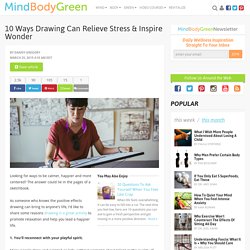
The answer could lie in the pages of a sketchbook. As someone who knows the positive effects drawing can bring to anyone's life, I'd like to share some reasons drawing is a great activity to promote relaxation and help you lead a happier life. 1. You'll reconnect with your playful spirit. Many people drew and painted as kids, without worrying about talent or the quality of the final product. 2. Drawing isn't a mysterious matter of God-given talent. 3. Making art stops time. 4. 11 tips to help your creativity explode. “You cannot teach a man anything.
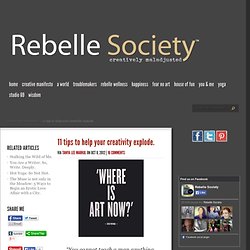
14 Tidbits to stir in your Coffee (or Tea) when the Sloth visits. I am not depressed but more like selectively choosing not to engage in a dramatic affair with life. I call it my inner sloth. Seasonal changes are like a giant toggle switch: I gather energy in spring and summer. By fall, I filter out the debris and prepare to slip into hibernation.
I’m getting ready for winter. I aim to seek balance though, as I dip a bit deeper into the long midnight blues. Meanwhile, my mind and body don’t do well from constant inertia. It’s a lesson of self-love versus judging myself harshly; a perpetual cognitive awareness to balance my needs. Can’t Meditate? Here’s Why You Should Try Art! The Challenge: We all have moments when we feel overwhelmed by our emotions.The Science: Creating art leads to surprising benefits for body and mind.The Solution: Make time for creativity to significantly improve your life!

Why Art is a Guarantee to Sanity Many of us have heard about the benefits of meditation, but sometimes find it hard to do so! Fewer of us know about the profound benefits of artistic expression. Creating art, however, is another way to access a meditative state of mind and the profound healing it brings. “Art is a guarantee to sanity,” said Louise Bourgeois, a French-American artist who died in 2010 at the age of 98. Art therapy has a healing effect for a variety of ailments (depression, trauma, illness, etc.) and is effective across age, gender or ethnicity. Art is not only healing for individuals suffering from severe illness. Coletterie. Whether you are a seasoned sewist or still learning, you may experience something I call DIY Anxiety from time to time.

Symptoms of DIY Anxiety include, but are not limited to: cold sweats, yelling at inanimate objects, reverting to childhood behaviors, and fabric-related nightmares. Loved ones may become concerned when you are found crying on a pile of what was supposed to be a pencil skirt. Today, we have a guest post from Annaliese Fidgeon, a sewist who lives in Seattle and blogs at a devoted novice. Annaliese had some great advice for those who feel like they’re losing steam with their sewing, and I wanted to share it with you today.
-Sarai Fortunately, DIY Anxiety can be prevented with self-awareness and discipline. Not enjoying yourself? Think I was joking about the crying bit above? Outrageously Alive: The Art of letting life chew you up & spit you back into the cosmos. By Anna Mattinger.
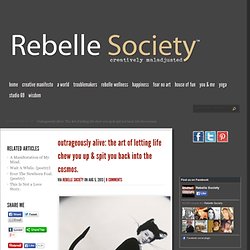
If art reflects life, then there seems little point in a life spent blocked off, tucked away from experience. So many of the artists I know sacrifice those unified experiences life has to offer in the name of making time for their art. They skive off personal connections, they avoid adventures, they stifle too much movement or activity, and they become perpetual homebodies, because they need to live within an incubator so they will have time to fiddle around ceaselessly, honing their skills or scrounging for materials… And the result is kitsch – aesthetics-driven art that appears to carry some weight at first glance.
Preachy-pulp-fiction-pop-culture-palatable writing. Hypothetical treatises of self-discovery. Reading Tolstoy or Camus or whatever other long-dead thinkers gleaned centuries ago can enhance your appreciation of humanity.
The Difference Between Routine and Ritual: How to Master the Balancing Act of Controlling Chaos and Finding Magic in the Mundane. By Maria Popova “The wonder of life is often most easily recognizable through habits and routines.”

A Sacred Journey - spirituality and intention in travels and daily life. The One True Thing About the Perfect Valentine’s Date. Is that it doesn’t exist.

Because the perfect Valentine’s date doesn’t seek perfection. It seeks reality. It acknowledges who we are as individuals and where we are as couples. Which means, the most loving Valentine’s date could happen in a restaurant. Or in a therapist’s office… 16 must-listen podcasts for creatives - Dear Handmade Life. Rebelle Society. Creativity and Courage, Failure. Jenna Avery. Joan Didion on Keeping a Notebook. By Maria Popova “We are well advised to keep on nodding terms with the people we used to be, whether we find them attractive company or not.”
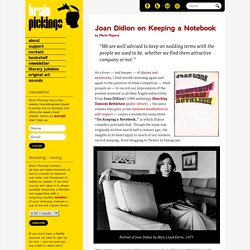
As a lover — and keeper — of diaries and notebooks, I find myself returning again and again to the question of what compels us — what propels us — to record our impressions of the present moment in all their fragile subjectivity. From Joan Didion’s 1968 anthology Slouching Towards Bethlehem (public library) — the same volume that gave us her timeless meditation on self-respect — comes a wonderful essay titled “On Keeping a Notebook,” in which Didion considers precisely that. Though the essay was originally written nearly half a century ago, the insights at its heart apply to much of our modern record-keeping, from blogging to Twitter to Instagram. Lynda Barry’s Syllabus: An Illustrated Field Guide to Keeping a Visual Diary and Cultivating the Capacity for Creative Observation.
By Maria Popova How to master the infinitely rewarding art of “being present and seeing what’s there.”
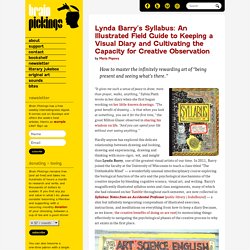
“It gives me such a sense of peace to draw; more than prayer, walks, anything,” Sylvia Plath wrote in her diary when she first began working on her little-known drawings. “The great benefit of drawing … is that when you look at something, you see it for the first time,” the great Milton Glaser observed in sharing his wisdom on life.